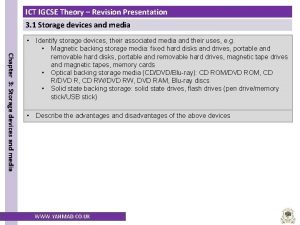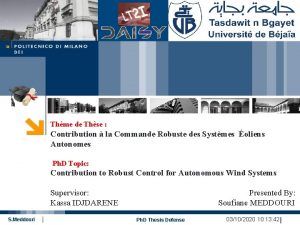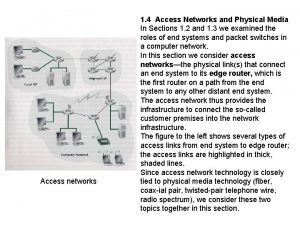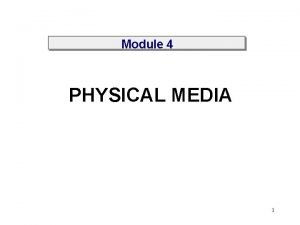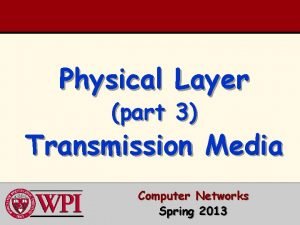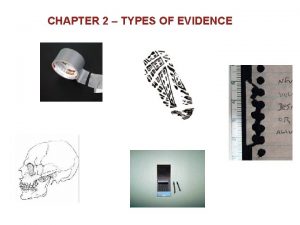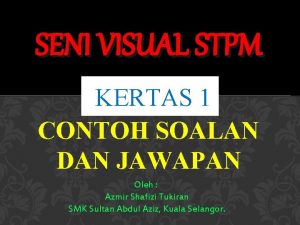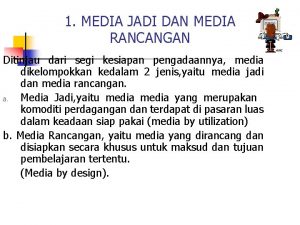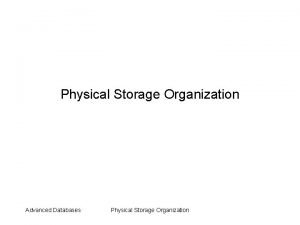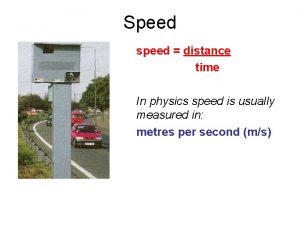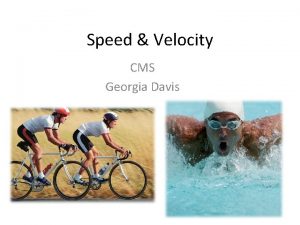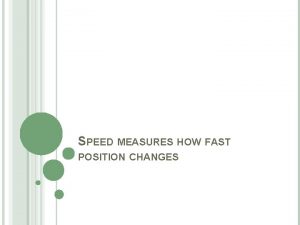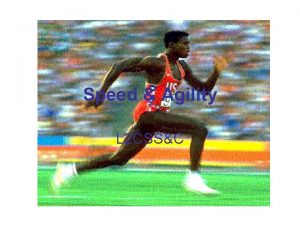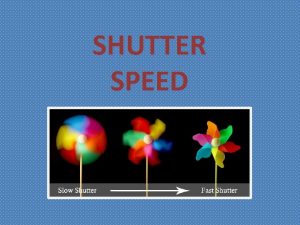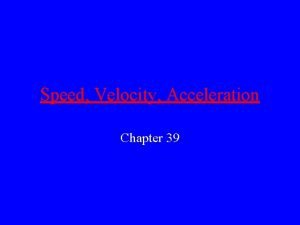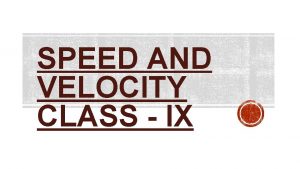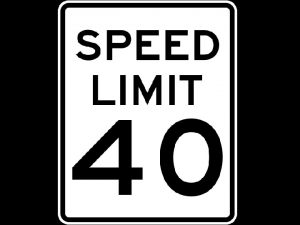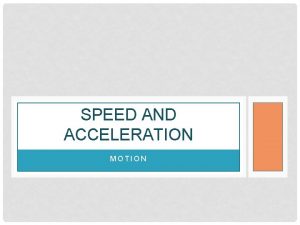Classification of Physical storage Media n Speed with





































- Slides: 37

Classification of Physical storage Media n Speed with which data can be accessed n Cost per unit of data n Reliability H data loss on power failure or system crash H physical failure of the storage device n We differentiate storage into: H volatile storage: loses contents when power is switched off H non-volatile storage: 4 Contents persist even when power is switched off. 4 Includes secondary and tertiary storage, as well as battery- backed main-memory. 1

Physical Storage Media n Cache – fastest and most costly form of storage; volatile; managed by the computer system hardware. n Main memory: H fast access (10 s to 100 s of nanoseconds; 1 nanosecond = 10– 9 seconds) H generally too small (or too expensive) to store the entire database 4 capacities of up to a few Gigabytes widely used currently 4 Capacities have gone up and per-byte costs have decreased steadily and rapidly (roughly factor of 2 every 2 to 3 years) H Volatile — contents of main memory are usually lost if a power failure or system crash occurs. 2

Physical Storage Media n Flash memory H Data survives power failure H Data can be written at a location only once, but location can be erased and written to again 4 Can support only a limited number of write/erase cycles. 4 Erasing of memory has to be done to an entire bank of memory H Reads are roughly as fast as main memory H But writes are slow (few microseconds), erase is slower H Cost per unit of storage roughly similar to main memory H Widely used in embedded devices such as digital cameras 3

Physical Storage Media n Magnetic-disk H Data is stored on spinning disk, and read/written magnetically H Primary medium for the long-term storage of data; typically stores entire database. H Data must be moved from disk to main memory for access, and written back for storage 4 Much slower access than main memory (more on this later) H direct-access – possible to read data on disk in any order, unlike magnetic tape H Hard disks vs floppy disks H Capacities range up to roughly 100 GB currently 4 Much larger capacity and cost/byte than main memory/flash memory 4 Growing constantly and rapidly with technology improvements (factor of 2 to 3 every 2 years) H Survives power failures and system crashes 4 disk failure can destroy data, but occur very rarely 4

Physical Storage Media n Optical storage H non-volatile, data is read optically from a spinning disk using a laser H CD-ROM (640 MB) and DVD (4. 7 to 17 GB) most popular forms H Write-one, read-many (WORM) optical disks used for archival storage (CD-R and DVD-R) H Multiple write versions also available (CD-RW, DVD-RW, and DVD-RAM) H Reads and writes are slower than with magnetic disk H Juke-box systems, with large numbers of removable disks, a few drives, and a mechanism for automatic loading/unloading of disks available for storing large volumes of data 5

Physical Storage Media n Tape storage H non-volatile, used primarily for backup (to recover H H from disk failure), and for archival data sequential-access – much slower than disk very high capacity (40 to 300 GB tapes available) tape can be removed from drive storage costs much cheaper than disk, but drives are expensive Tape jukeboxes available for storing massive amounts of data 4 hundreds of terabytes (1 terabyte = 109 bytes) to even a petabyte (1 petabyte = 1012 bytes) 6

Storage Hierarchy 7

Storage Hierarchy n primary storage: Fastest media but volatile (cache, main memory). n secondary storage: next level in hierarchy, non- volatile, moderately fast access time H also called on-line storage H E. g. flash memory, magnetic disks n tertiary storage: lowest level in hierarchy, non- volatile, slow access time H also called off-line storage H E. g. magnetic tape, optical storage 8

Magnetic Hard Disk Mechanism 9

Magnetic Disks n Read-write head - Reads or writes magnetically encoded n n information. Surface of a platter is divided into circular tracks H Over 16, 000 tracks per platter on typical hard disks Each track is divided into sectors. H A sector is the smallest unit of data that can be read or written. H Sector size typically 512 bytes H Typical sectors per track: 200 (on inner tracks) to 400 (on outer tracks) Head-disk assemblies H multiple disk platters on a single spindle (typically 2 to 4) H one head per platter, mounted on a common arm. Cylinder i consists of ith track of all the platters 10

Magnetic Disks n Disk controller – interfaces between the computer system and the disk drive hardware. H accepts high-level commands to read or write a sector H initiates actions such as moving the disk arm to the right track and actually reading or writing the data H Computes and attaches checksums to each sector to verify that data is read back correctly 4 If data is corrupted, with very high probability stored checksum won’t match recomputed checksum H Ensures successful writing by reading back sector after writing it H Performs remapping of bad sectors 11

Disk Subsystem n Multiple disks connected to a computer system through a controller H Controllers functionality (checksum, bad sector remapping) often carried out by individual disks; reduces load on controller n Disk interface standards families H ATA (AT adaptor) range of standards H SCSI (Small Computer System Interconnect) range of standards H Several variants of each standard (different speeds and capabilities) 12

Performance Measures of Disks n Access time – the time it takes from when a read or write request is issued to when data transfer begins. Consists of: H Seek time – time it takes to reposition the arm over the correct track. 4 Average seek time is 1/2 the worst case seek time. 4 4 to 10 milliseconds on typical disks H Rotational latency – time it takes for the sector to be accessed to appear under the head. 4 Average latency is 1/2 of the worst case latency. 4 4 to 11 milliseconds on typical disks H Data-transfer rate – the rate at which data can be retrieved from or stored to the disk. 4 4 to 8 MB per second is typical H Multiple disks may share a controller, so transfer rate that controller can handle is also important 4 E. g. ATA-5: 66 MB/second, SCSI-3: 40 MB/s 4 Fiber Channel: 256 MB/s 13

Performance Measures n Mean time to failure (MTTF) – the average time the disk is expected to run continuously without any failure. H Typically 3 to 5 years H Probability of failure of new disks is quite low, corresponding to a “theoretical MTTF” of 30, 000 to 1, 200, 000 hours for a new disk 4 E. g. , an MTTF of 1, 200, 000 hours for a new disk means that given 1000 relatively new disks, on an average one will fail every 1200 hours H MTTF decreases as disk ages 14

Optimization of Disk-Block Access n Block – a contiguous sequence of sectors from a single track H sizes range from 512 bytes to several kilobytes 4 Smaller blocks: more transfers from disk 4 Larger blocks: more space wasted due to partially filled blocks 4 Typical block sizes today range from 4 to 16 kilobytes n Disk-arm-scheduling algorithms order pending accesses to tracks so that disk arm movement is minimized H elevator algorithm : move disk arm in one direction (from outer to inner tracks or vice versa), processing next request in that direction, till no more requests in that direction, then reverse 15

Optimization of Disk Block Access n File organization – optimize block access time by organizing the blocks to correspond to how data will be accessed H E. g. Store related information on the same or nearby cylinders. H Files may get fragmented over time 4 E. g. if data is inserted to/deleted from the file 4 Or free blocks on disk are scattered, and newly created file has its blocks scattered over the disk 4 Sequential access to a fragmented file results in increased disk arm movement H Some systems have utilities to defragment the file system, in order to speed up file access 16

Optimization of Disk Block Access n Nonvolatile write buffers speed up disk writes by writing blocks to a non-volatile RAM buffer immediately H Non-volatile RAM: battery backed up RAM or flash memory H Controller then writes to disk whenever the disk has no other requests or request has been pending for some time H Database operations that require data to be safely stored before continuing can continue without waiting for data to be written to disk H Writes can be reordered to minimize disk arm movement n Log disk – a disk devoted to writing a sequential log of block updates H Used exactly like nonvolatile RAM 4 Write to log disk is very fast since no seeks are required 17

Improvement of Reliability via Redundancy n Redundancy – store extra information that can be used to rebuild information lost in a disk failure n E. g. , Mirroring (or shadowing) H Duplicate every disk. Logical disk consists of two physical disks. H Every write is carried out on both disks H If one disk in a pair fails, data still available in the other 4 Data loss would occur only if a disk fails, and its mirror disk also fails before the system is repaired n Mean time to data loss depends on mean time to failure, and mean time to repair H E. g. MTTF of 100, 000 hours, mean time to repair of 10 hours gives mean time to data loss of 500*106 hours (or 57, 000 years) for a mirrored pair of disks (ignoring dependent failure modes) 18

Improvement in Performance via Parallelism n Two main goals of parallelism in a disk system: 1. Load balance multiple small accesses to increase throughput 2. Parallelize large accesses to reduce response time. n Improve transfer rate by striping data across multiple disks. n Bit-level striping – split the bits of each byte across multiple disks H In an array of eight disks, write bit i of each byte to disk i. H Each access can read data at eight times the rate of a single disk. H But seek/access time worse than for a single disk 4 Bit level striping is not used much any more n Block-level striping – with n disks, block i of a file goes to disk (i mod n) + 1 H Requests for different blocks can run in parallel if the blocks reside on different disks H A request for a long sequence of blocks can utilize all disks in parallel 19

Optical Disks n Compact disk-read only memory (CD-ROM) H Disks can be loaded into or removed from a drive H High storage capacity (640 MB per disk) H High seek times or about 100 msec (optical read head is heavier and slower) H Higher latency (3000 RPM) and lower data-transfer rates (3 -6 MB/s) compared to magnetic disks n Digital Video Disk (DVD) H DVD-5 holds 4. 7 GB , and DVD-9 holds 8. 5 GB H DVD-10 and DVD-18 are double sided formats with capacities of 9. 4 GB and 17 GB n Record once versions (CD-R and DVD-R) are becoming popular H data can only be written once, and cannot be erased. H high capacity and long lifetime; used for archival storage H Multi-write versions (CD-RW, DVD-RW and DVD-RAM) also available 20

Magnetic Tapes n Hold large volumes of data and provide high transfer rates H Transfer rates from few to 10 s of MB/s n Currently the cheapest storage medium H Tapes are cheap, but cost of drives is very high n Very slow access time in comparison to magnetic disks and optical disks H limited to sequential access. H Some formats provide faster seek (10 s of seconds) at cost of lower capacity n Used mainly for backup, for storage of infrequently used information, and as an off-line medium for transferring information from one system to another. 21

Storage Access n A database file is partitioned into fixed-length storage units called blocks. Blocks are units of both storage allocation and data transfer. n Database system seeks to minimize the number of block transfers between the disk and memory. We can reduce the number of disk accesses by keeping as many blocks as possible in main memory. n Buffer – portion of main memory available to store copies of disk blocks. n Buffer manager – subsystem responsible for allocating buffer space in main memory. 22

Buffer Manager n Programs call on the buffer manager when they need a block from disk. 1. If the block is already in the buffer, the requesting program is given the address of the block in main memory 2. If the block is not in the buffer, 1. the buffer manager allocates space in the buffer for the block, replacing (throwing out) some other block, if required, to make space for the new block. 2. The block that is thrown out is written back to disk only if it was modified since the most recent time that it was written to/fetched from the disk. 3. Once space is allocated in the buffer, the buffer manager reads the block from the disk to the buffer, and passes the address of the block in main memory to requester. 23

Buffer-Replacement Policies n Most operating systems replace the block least recently used (LRU strategy) n Idea behind LRU – use past pattern of block references as a predictor of future references n Queries have well-defined access patterns (such as sequential scans), and a database system can use the information in a user’s query to predict future references H LRU can be a bad strategy for certain access patterns involving repeated scans of data 4 e. g. when computing the join of 2 relations r and s by a nested loops for each tuple tr of r do for each tuple ts of s do if the tuples tr and ts match … H Mixed strategy with hints on replacement strategy provided by the query optimizer is preferable 24

Buffer-Replacement Policies n Pinned block – memory block that is not allowed to be n n written back to disk. Toss-immediate strategy – frees the space occupied by a block as soon as the final tuple of that block has been processed Most recently used (MRU) strategy – system must pin the block currently being processed. After the final tuple of that block has been processed, the block is unpinned, and it becomes the most recently used block. Buffer manager can use statistical information regarding the probability that a request will reference a particular relation H E. g. , the data dictionary is frequently accessed. Heuristic: keep data-dictionary blocks in main memory buffer Buffer managers also support forced output of blocks for the purpose of recovery 25

File Organization n The database is stored as a collection of files. Each file is a sequence of records. A record is a sequence of fields. n One approach: H assume record size is fixed H each file has records of one particular type only H different files are used for different relations This case is easiest to implement; will consider variable length records later. 26

Fixed-Length Records n Simple approach: H Store record i starting from byte n (i – 1), where n is the size of each record. H Record access is simple but records may cross blocks 4 Modification: do not allow records to cross block boundaries n Deletion of record I: alternatives: H move records i + 1, . . . , n to i, . . . , n – 1 H move record n to i H do not move records, but link all free records on a free list 27

Free Lists n Store the address of the first deleted record in the file header. n Use this first record to store the address of the second deleted record, and so on n Can think of these stored addresses as pointers since they “point” to the location of a record. n More space efficient representation: reuse space for normal attributes of free records to store pointers. (No pointers stored in in-use records. ) 28

Variable-Length Records n Variable-length records arise in database systems in several ways: H Storage of multiple record types in a file. H Record types that allow variable lengths for one or more fields. H Record types that allow repeating fields (used in some older data models). n Byte string representation H Attach an end-of-record ( ) control character to the end of each record H Difficulty with deletion H Difficulty with growth 29

Variable-Length Records: Slotted Page Structure n Slotted page header contains: H number of record entries H end of free space in the block H location and size of each record n Records can be moved around within a page to keep them contiguous with no empty space between them; entry in the header must be updated. n Pointers should not point directly to record — instead they should point to the entry for the record in header. 30

Variable-Length Records n Fixed-length representation: H reserved space H pointers n Reserved space – can use fixed-length records of a known maximum length; unused space in shorter records filled with a null or end-of-record symbol. 31

Pointer Method n Pointer method H A variable-length record is represented by a list of fixedlength records, chained together via pointers. H Can be used even if the maximum record length is not known 32

Pointer Method n Disadvantage to pointer structure; space is wasted in all records except the first in a a chain. n Solution is to allow two kinds of block in file: H Anchor block – contains the first records of chain H Overflow block – contains records other than those that are the first records of chairs. 33

Organization of Records in Files n Heap – a record can be placed anywhere in the file where there is space n Sequential – store records in sequential order, based on the value of the search key of each record n Hashing – a hash function computed on some attribute of each record; the result specifies in which block of the file the record should be placed n Records of each relation may be stored in a separate file. In a clustering file organization records of several different relations can be stored in the same file H Motivation: store related records on the same block to minimize I/O 34

Sequential File Organization n Suitable for applications that require sequential processing of the entire file n The records in the file are ordered by a search-key 35

Sequential File Organization n Deletion – use pointer chains n Insertion –locate the position where the record is to be inserted H if there is free space insert there H if no free space, insert the record in an overflow block H In either case, pointer chain must be updated n Need to reorganize the file from time to restore sequential order 36

Clustering File Organization n Simple file structure stores each relation in a separate file n Can instead store several relations in one file using a clustering file organization n E. g. , clustering organization of customer and depositor: n l scan using a secondary index is expensive H each record access may fetch a new block from disk n an entry was deleted from their parent) n Root node then had only one child, and was deleted and its child became the new root node n Hhigh. good for queries involving depositor customer, and for queries involving one single customer and his accounts H bad for queries involving only customer H results in variable size records 37
 Physical media storage
Physical media storage Find speed
Find speed How emotions affect driving
How emotions affect driving Speed detection of moving vehicle
Speed detection of moving vehicle Primary storage and secondary storage
Primary storage and secondary storage Primary storage and secondary storage
Primary storage and secondary storage Secondary storage provides temporary or volatile storage
Secondary storage provides temporary or volatile storage Object based and unified storage
Object based and unified storage Igcse ict chapter 3
Igcse ict chapter 3 2.thme
2.thme Rate fences services marketing
Rate fences services marketing What is physical fitness test in mapeh
What is physical fitness test in mapeh Physical media meaning
Physical media meaning Transmission media
Transmission media Residential access networks
Residential access networks Physical layer transmission media
Physical layer transmission media Physical media types
Physical media types Physical transmission media
Physical transmission media Components of computer network
Components of computer network Transmission medias
Transmission medias Classification of physical evidence
Classification of physical evidence Selective and differential media
Selective and differential media Media
Media Gross rating points
Gross rating points Two types of people media
Two types of people media Alta edad media y baja edad media
Alta edad media y baja edad media Caracteristicas de la baja edad media
Caracteristicas de la baja edad media Difference between hot media and cold media
Difference between hot media and cold media Selective and differential media
Selective and differential media A level media component 2
A level media component 2 Soalan stpm seni visual penggal 2
Soalan stpm seni visual penggal 2 Hot media and cold media
Hot media and cold media Moyens de communication hors média
Moyens de communication hors média Wired data transfer
Wired data transfer Perbedaan media jadi dan media rancang
Perbedaan media jadi dan media rancang Hot cold media
Hot cold media New media vs old media
New media vs old media Opinion image
Opinion image








